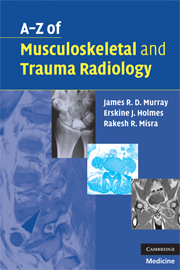Book contents
- Frontmatter
- Contents
- Acknowledgements
- Preface
- List of abbreviations
- Section I Musculoskeletal radiology
- Section II Trauma radiology
- ATLS – Advanced Trauma Life Support
- Acetabular fractures
- Aortic rupture
- Cervical spine injury
- Flail chest
- Haemothorax
- Open fractures
- Pelvic fracture
- Peri-physeal injury
- Pneumothorax
- Rib/sternal fracture
- Skull fracture
- Thoraco-lumbar spine fractures
- Acromioclavicular joint injury
- Carpal dislocation and instability
- Clavicular fractures
- Elbow injuries and distal humeral fractures
- Hand injuries – general principles
- Hand injuries – specific examples
- Thumb metacarpal fractures
- Humerus fracture – proximal fractures
- Humerus fracture – shaft fractures
- Humerus fracture – supracondylar fractures – paediatric
- Radius fracture – head of radius fractures
- Radius fracture – shaft fractures
- Galeazzi fracture dislocation
- Radius fracture – distal radial fractures
- Related wrist fractures
- Scaphoid fracture
- Scapular fracture
- Shoulder dislocation
- Ulna fracture – proximal and olecranon fractures
- Ulna fracture – shaft fractures
- Monteggia fracture dislocation
- Accessory ossicles of the foot
- Ankle fractures
- Bone bruising
- Calcaneal (Os calcis) fractures
- Femoral neck fracture
- Femoral shaft fracture
- Femoral supracondylar fracture
- Hip dislocation – traumatic
- Knee soft-tissue injury
- Metatarsal fractures – commonly fifth MT base
- Patella fracture
- Tibial-plateau fracture
- Tibial-shaft fractures
- Tibial-plafond (Pilon) fractures
- Talus fractures/dislocations
Tibial-plateau fracture
from Section II - Trauma radiology
Published online by Cambridge University Press: 22 August 2009
- Frontmatter
- Contents
- Acknowledgements
- Preface
- List of abbreviations
- Section I Musculoskeletal radiology
- Section II Trauma radiology
- ATLS – Advanced Trauma Life Support
- Acetabular fractures
- Aortic rupture
- Cervical spine injury
- Flail chest
- Haemothorax
- Open fractures
- Pelvic fracture
- Peri-physeal injury
- Pneumothorax
- Rib/sternal fracture
- Skull fracture
- Thoraco-lumbar spine fractures
- Acromioclavicular joint injury
- Carpal dislocation and instability
- Clavicular fractures
- Elbow injuries and distal humeral fractures
- Hand injuries – general principles
- Hand injuries – specific examples
- Thumb metacarpal fractures
- Humerus fracture – proximal fractures
- Humerus fracture – shaft fractures
- Humerus fracture – supracondylar fractures – paediatric
- Radius fracture – head of radius fractures
- Radius fracture – shaft fractures
- Galeazzi fracture dislocation
- Radius fracture – distal radial fractures
- Related wrist fractures
- Scaphoid fracture
- Scapular fracture
- Shoulder dislocation
- Ulna fracture – proximal and olecranon fractures
- Ulna fracture – shaft fractures
- Monteggia fracture dislocation
- Accessory ossicles of the foot
- Ankle fractures
- Bone bruising
- Calcaneal (Os calcis) fractures
- Femoral neck fracture
- Femoral shaft fracture
- Femoral supracondylar fracture
- Hip dislocation – traumatic
- Knee soft-tissue injury
- Metatarsal fractures – commonly fifth MT base
- Patella fracture
- Tibial-plateau fracture
- Tibial-shaft fractures
- Tibial-plafond (Pilon) fractures
- Talus fractures/dislocations
Summary
Characteristics
Increasingly seen in the elderly (approx 10% of fractures seen in the elderly).
Intra-articular injury and thus result in loss of joint congruity.
Lateral tibial-plateau fractures are most common.
Beware avulsion fracture of the lateral tibial plateau (Segond fracture) as this is often associated with anterior cruciate injury – see soft tissue knee.
Medial plateau fractures are uncommon and may be associated with lateral ligament ruptures and common peroneal nerve palsy.
Classified according to Schatzker – types I–VI (see table).
50% have a meniscal injury and 30% have an associated ligamentous injury.
Clinical features
Suspect in a non-weight-bearing patient with history of fall or RTA.
Bruising, joint effusion, deformity (usually valgus) of the knee.
The clinical effusion is due to a lipohaemarthrosis and is often tense.
Always examine and document the neurovascular status as the relatively immobile popliteal vasculature and peroneal nerve can be damaged, especially in bicondylar and medial plateau fractures respectively.
Further examination under GA (after bony ORIF) to assess ligament damage.
Radiological features
AP and horizontal lateral are usually enough, although a subtle fracture may be revealed on an oblique film.
Look for a lipo haemarthrosis on the horizontal-beam lateral X-ray.
Look closely for bony avulsion fragments and widening of the joint space in the unaffected compartment as these are suggestive of associated ligamentous injury.
CT is useful in planning surgery.
MRI is useful for soft-tissue information – menisci and ligaments particularly.
Management
ABCs, assess soft tissues, neurovascular status and immobilise with backslab.
Non-operative treatment includes immobilisation in plaster followed by hinged cast and rehabilitation – suitable for minimal articular damage particularly in the elderly patient.
For the majority of displaced fractures, open reduction and internal fixation possibly with arthroscopic assistance is required.
[…]
- Type
- Chapter
- Information
- A-Z of Musculoskeletal and Trauma Radiology , pp. 329 - 331Publisher: Cambridge University PressPrint publication year: 2008



